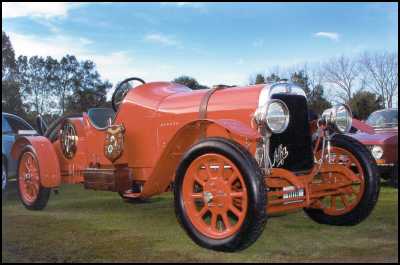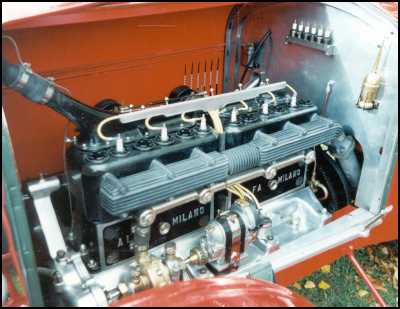Images: Very First Alfa Romeo Finds A Home
The Very First Alfa Romeo Finds A Home With New Zealand's Alfa Importer


The very first Alfa Romeo, the Alfa Romeo G1, and the only one left in the world has found a new home with Ateco Automotive, the New Zealand Alfa Romeo importer.
The Alfa Romeo Museum, the guardian of all things Alfa Romeo, has confirmed that it regards the Alfa Romeo G1 as the very first true Alfa Romeo - all cars prior to this were either Alfas, being built prior to the purchase of the company by Nicola Romeo, or Darracq cars built under license - and the museum has confirmed that Alfa Romeo G1 chassis and engine number 6018 is the only Alfa Romeo G1 left in existence.
"It is a great honour to be owner of the very first Alfa Romeo, the car that gave birth to one of the most famous car marques of all time," says Neville Crichton, Governing Director of Ateco Automotive. "We plan to complete the restoration of this magnificent and historic car and then ensure that as many people can enjoy it by displaying it around New Zealand and Australia."
The 6.3 litre straight six Alfa Romeo G1 clearly demonstrates Alfa Romeo's sports performance lineage, which runs right through to today's six cylinder Alfa Romeo sports cars and sports sedans. And, of course, it is bright red and lined with hand stitched leather upholstery.
But magnificent as it looks today, it has had a very mixed history since it arrived in Australia almost exactly 80 years ago.
Chassis 6018 was imported new into Australia in 1921 and was sold, for £850, to a Queensland businessman who, soon afterwards, was declared bankrupt.
Since he had seen his crash coming, he hid the car to keep it out of the hands of his creditors. Then, three years on, he had the misfortune to die and the G1 remained hidden for 25 years, apparently holding up one corner of a shed in the Queensland outback.
Then it was discovered by a couple of young jackaroos who decided it would make a fine 'paddock bomb' for rounding up cattle, chasing kangaroos and all the stuff that blokes do on farms. Eventually they managed to hit a tree and the damaged car was towed back to the farm where it was used to power a water pump. With its massive torque at low engine speed, it was ideal for the job and the work ensured that the engine remained in excellent condition even if the rest of the car was brutalised.
In 1964 it was retired from pump duty and rescued by Alfa Romeo enthusiasts. The following year the car was bought by Ross Flewell-Smith who, against the advice of some experts who thought the car unrestorable, began to rebuild it, an exercise that took ten years. In this Herculean task he was helped by the fact that he discovered a second G1, a wreck, which supplied many of the parts that were missing. Most of the body was missing and, after experimenting with various styles, Flewell-Smith took advice from Luigi Fusi who was then curator of Alfa Romeo's museum.
Flewell-Sinith's rebuild was good enough to win the 1977 Queensland Vintage Car Concours and to win the 1978 Australian Mile Miglia memorial run. In an historic race at Lakeside it was clocked at 86 mph, remarkable performance for a 1921 car, so remarkable, in fact, it was black-flagged for being so quick!
In 1995, Flewell-Smith sold this car he had nicknamed 'Milly' from the 'Milan' on the engine black, to Julian Sterling who commissioned a restoration to his own exacting standards. All worn parts were replaced with specially-made components built regardless of cost. New tyres were supplied by Michelin, made from the original 1920s moulds, costing $6,000 for the set. The restoration was undertaken up to a standard, not down to a price, and the work was described in the 1998 edition of the Classic Car Yearbook as 'breathtaking'.
Following a rationalization of Julian Sterling's car collection, the car was bought by Neville Crichton, the governing director of the New Zealand Alfa Romeo importer, Ateco Automotive.
The Alfa Romeo G1 and its place in Alfa Romeo's history Alfa Romeo had its roots in the Società Italinana Automobili Darracq (SIAD) which was founded in November 1906 to assemble French Darracq cars for the Italian market. Darracq's products, however, were not suited to Italian needs and conditions and though the new concern was intended to build 600 cars a year, it built just 300 in 1908 and a mere 61 in 1909. SIAD was liquidated and the factory was bought by a consortium of Milanese businessmen who founded Anonima Lombardo Fabrica Automobili, (ALFA).
The first ALFA cars were based on Darracq designs but the company was soon making cars designed by the former FIAT engineer, Cavaliere Giuseppe Merosi, and these proved very popular. Before long ALFA was making 3100 cars a year, then came the First World War.
In 1915 Nicola Romeo, a successful mining engineer and maker of a very popular portable compressor known as 'The Little Italian' took over the ALFA factory to build tractors, ploughs and aircraft engines. As soon as the war was over, Alfa-Romeo (with a hyphen) returned to making cars.
The first Alfa Romeo car (no hyphen) was the G 1, designed by Giuseppe Merosi. The G1 was a luxury car powered by a six-cylinder side-valve 6330cc engine, the largest engine ever fitted to an Alfa Romeo, and this was probably the reason why only 52 examples of the G1 were made. It arrived on the market just as petrol prices were raised and since the G1 returned only about six miles to the gallon it was not flavour of the month.
The G1 was, however, advanced for its time. The engine, with two cast iron blacks each of three cylinders, produced 70 bhp at an unstressed 2,100 rpm, a phenomenal 217 lb/ft torque at 1,100 rpm, and it drove through a four-speed gearbox. The chassis was pure vintage with semi-elliptical springs at the front, dual quarter-elliptics at the rear, a unique feature, and, it being 1921, the mechanical brakes were on the rear wheels only with the footbrake operating on the transmission. It also started Alfa Romeo's motorsport heritage, finishing first in its category in its first outing, in the Coppa de Garda.
The G1 was the first model designed specifically as an Alfa Romeo and it is the grandparent of the immortal Alfa Romeo P2, P3, Monza and Alfetta as well as the modern range of Alfa Romeos, the Alfa 147, 156, 166, GTV and Spider.
Alfa Romeo G1 - Technical Specification
Engine
Front longitudinal mounted driving the rear wheels
Engine
type Straight six, cast iron double block and fixed
heads
Capacity (cc) 6330
Bore x stroke (mm) 98
x 140
Compression ratio 4.6:1
Power (bhp/rpm)
70/2100
Torque (lb/ft/rpm) 217/1100
Valves Side
vales, one laterally mounted camshaft, chain
driven
Cooling system 16 lire pressurized water cooling
with mechanical fan
Fuel system Mechanical pump, one
vertical single barrel carburetor
Fuel tank Rear
mounted, 75 litres
Lubrication Pressurized, sump
capacity 9 litres
Transmission 4 speed manual
mechanical gearbox with reverse gear,
lateral floor
mounted gear lever
Clutch Dry dual plate
Suspension -
front Rigid axle, semi-elliptic longitudinal
leaf
springs
Suspension - rear Rigid axle,
double semi-elliptic
longitudinal
leaf
springs
Wheels Cast iron
spoke
Tyres 895 x 135
Brakes - foot No front
brakes, rear drums
Brakes - hand Acts on the rear
drum
Steering Worm and wheel
Electrical system
12 volt with a generator
Dimensions Length: 4,494mm;
Wheelbase 3400mm; Front track 1445mm;
Rear
track
1445mm
Weight Unladen 1500kg
(ends)


 Consumer NZ: Despite Low Confidence In Government Efforts, People Want Urgent Action To Lower Grocery Bills
Consumer NZ: Despite Low Confidence In Government Efforts, People Want Urgent Action To Lower Grocery Bills NZ Banking Association: Banks Step Up Customer Scam Protections And Compensation
NZ Banking Association: Banks Step Up Customer Scam Protections And Compensation The Reserve Bank of New Zealand: CoFR Seeking Feedback On Access To Basic Transaction Accounts
The Reserve Bank of New Zealand: CoFR Seeking Feedback On Access To Basic Transaction Accounts 2Degrees: Stop The Pings - Half Of Kiwis Overwhelmed By Notifications
2Degrees: Stop The Pings - Half Of Kiwis Overwhelmed By Notifications Electricity Networks Association: How Many More Trees Need To Fall On Power Lines Before The Rules Change?
Electricity Networks Association: How Many More Trees Need To Fall On Power Lines Before The Rules Change? Parrot Analytics: Netflix Earnings - Price Hikes With Minimal Churn | Will Netflix Be A Bright Spot For Markets?
Parrot Analytics: Netflix Earnings - Price Hikes With Minimal Churn | Will Netflix Be A Bright Spot For Markets?



